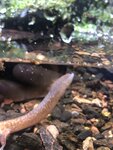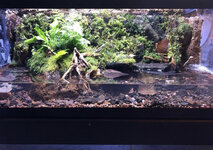My adult Spring Salamander has a white spot on its tail. Does not look like fungal infection as I’ve seen those before, but I can’t be sure. Guessing it could have gotten a mild injury or maybe bacterial? It’s eating and very active. The water is cool in the enclosure and filtered by an external canister filter (check water parameters every few days) and do a partial RO water change every week. Here are. A few pics. Want to nip this early if it’s something that requires a vet visit. Any advice is appreciated
Caudata.org: Newts and Salamanders Portal
Register a free account today to become a member! Once signed in, you'll be able to participate on this site by adding your own topics and posts, as well as connect with other members through your own private inbox!
Did you know that registered users see fewer ads? Register today!
-
Did you know that registered users see fewer ads? Register today!
White Spot on Spring Salamander tail?
- Thread starter Mike777
- Start date
- No one is chatting at the moment.
-
Shane douglas:with axolotls would I basically have to keep buying and buying new axolotls to prevent inbred breeding which costs a lot of money??+1
-
Thorninmyside:Not necessarily but if you’re wanting to continue to grow your breeding capacity then yes. Breeding axolotls isn’t a cheap hobby nor is it a get rich quick scheme. It costs a lot of money and time and deditcation+1
-
Clareclare:Would Chinese fire belly newts be more or less inclined towards an aquatic eft set up versus Japanese . I'm raising them and have abandoned the terrarium at about 5 months old and switched to the aquatic setups you describe. I'm wondering if I could do this as soon as they morph?+1
Clareclare:
Would Chinese fire belly newts be more or less inclined towards an aquatic eft set up versus...
+1




